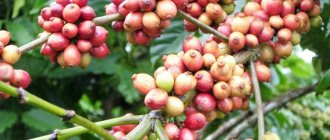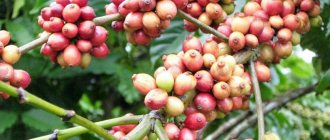Ethiopia (formerly Abyssinia) is the birthplace of Arabica; coffee beans have been grown here for more than a thousand years. Despite this, the share of Ethiopian coffee on the world market is only 3%, however, even such modest indicators play a significant role in the state’s economy: more than 30% of export profits come from coffee.
Etymology. The original name for coffee, kaffa, comes from the region in southeastern Ethiopia where the plant was first discovered. In the local language, the coffee tree is called bunn or buna. Accordingly, the term passed into the “big world” as Kaffa bunn (“bann” from Kaffa), then bunn was modified into bean (from English - beans) and the fruits turned into “coffee beans”, although in fact they are in no way related to legumes relate.
Story
According to legend, in the 9th century, the Abyssinian shepherd Kaldim noticed that, after eating the fruits of the coffee tree, his goats became especially excited, became cheerful and energetic, made loud noises and danced on their hind legs. The brave goatherd himself tried the bright red berries and felt how they filled the body with energy.
Kaldim shared his discovery with the abbot of the local monastery, but he declared it to be the work of the devil and threw the grains into the fire. Soon the aroma of roasted coffee floated through the room, the holy father changed his anger to mercy, took out the grains, ground them finely and poured hot water over the powder to preserve the fruits longer. So the priest learned to brew an invigorating drink so that the monks would not fall asleep during prayer. This story was first mentioned in records in 1671, but its authenticity remains questionable.
Kadim and his goats
According to an alternative version, the honor of discovering coffee belongs to the Muslim hermit Sheikh Omar from Yemen, who lived in the Mocha region.
As for historical facts, there is evidence that coffee beans were eaten in Yemen as early as the 6th century. Initially, they were not brewed, but chewed, mixed with flour and fat, and cakes were made from this mass, which were eaten on long journeys.
In some Abyssinian tribes, coffee berries were fermented (fermented) and wine was made from them, in others they made porridge from coffee.
Grinding coffee beans into powder and brewing the drink began closer to the 13th century, at which time the invigorating decoction spread beyond Ethiopia and became popular in Muslim countries.
On the way to democracy
In 1991, the Ethiopian Peoples' Revolutionary Democratic Front overthrew the military dictatorship. The process of liberalization began, and the country embarked on the path of democracy. Ethiopia's international markets have opened up, but with it comes the exposure to fluctuating market prices that Ethiopian coffee farmers have had to contend with. Uncontrolled price changes have led to the creation of cooperatives that offer assistance to their members: financing, information about the market situation and transport services.
Production
Ethiopia ranks first in coffee production in Africa and fifth in the world. About half of the products are exported, the rest is sold on the local market.
Ethiopia is literally made for growing coffee: it has ideal weather conditions, fertile soil, and a suitable climate. Most coffee will grow in natural conditions: among other plants, in the shade of trees, without the use of fertilizers or chemicals.
This is the only country where coffee trees are not only cultivated on plantations, but also found in the wild.
Production methods have not changed much over the past hundreds of years: coffee in Ethiopia is still planted, cultivated, harvested and dried primarily by hand. The approximate area of all land allocated for coffee farming is 4000 m² - it is difficult to calculate more precisely, because we are not talking about large plantations, but about many small farms.
Hand-picked Arabica
The large-scale export of coffee to markets in neighboring countries did not make Ethiopia a rich state. Therefore, coffee is grown mainly by small farmers, and the main processes are performed manually. Collecting fruits is a complex, meticulous process and requires a lot of experience from workers. Drying of grains is also not automated and therefore occurs gradually.
Ethiopia is the cradle of coffee, because from Africa it spread to other continents.
Taste characteristics
Ethiopian coffee has a bright fruity-floral aroma, pronounced sourness, and a complex bouquet. It makes a light to medium-bodied drink.
The taste is largely determined by the method of processing coffee cherries. In Ethiopia they use both:
- Wet: the fruit pulp is removed immediately after picking the berries with plenty of water. The remaining fibers undergo a short fermentation and are also washed off. These grains have a bright, complex and very clean taste.
- Dry (aka “natural”). The fruits are dried in the sun and the pulp is removed before export or roasting. Such grains acquire more berry and chocolate tones, the drink turns out sweetish, as if a little syrup was added to it.
The dry processing method is much cheaper, so it is used more often in Ethiopia.
What makes the grains unique?
The climate here is milder than in other African territories, and allows for high humidity and temperatures of 25-30 degrees all year round.
However, due to the terrain, fluctuations during the day and night can reach 15°C. Therefore, coffee trees are often planted next to taller banana trees to provide shade during hot afternoons and to retain warmth after sunset. In the forest, such a protective screen is formed naturally.
In addition, here, as with coffee from Yemen, the tradition of growing only organic varieties, that is, without artificial fertilizers, is maintained.
The grains are harvested from mid-summer until the end of January. The tree thickets are quite dense, so the entire harvest is harvested by hand. The coffee is then most often given a dry process, in which the beans are not separated from the pulp during drying. This allows them to absorb all the flavor and aroma from the pulp and gluten, and then transfer it to the drink, which acquires a unique sweetness and richness.
The method can come in two versions. In the first case, several layers of leaves, usually palm leaves, are laid out on the ground. Grains are scattered on them for drying under the sun, which lasts approximately 15-28 days, depending on the thickness of the layer. Another option involves collecting only ripe berries that have had time to ripen, dry on the tree and fall to the ground.
Types of Ethiopian coffee
In total, there are more than a thousand types of coffee beans in the country. Until 1995, Ethiopia was divided into provinces, today they have been replaced by districts, but the familiar provincial names are still widely used to refer to coffee.
Many coffee farms are located in the southernmost province of Sidamo, in particular, one of the best types of coffee in the world is produced here - Yirgacheffe. The same province supplies the world market with Guji coffee, which has notes of melon, jasmine and peach.
Genika is a type of Arabica grown exclusively in the Bench Maji area. The beans have a rich aroma with notes of spices, wine, chocolate and flowers. The Harar variety from the region of the same name is also very popular - it produces full-bodied coffee with a distinct sourness and mocha flavor. Kharar grains are processed only in a dry way (dried in the sun, then the pulp is peeled off).
Ethiopia is one of the few countries in which “wild” Arabica remains. Those very first trees, the fruits of which were tested and later began to be processed and cultivated. Not everyone knows that initially the local population did not pay any attention to coffee beans. Tea was brewed from the leaves of the trees, and quite strong alcohol was infused from the fruits. Now, of course, most of the territory of this country is occupied by human plantations, but wild trees can also be found.
Ethiopian Arabica has one difference - it is more spicy, oily, has a bright bitterness and a completely unnoticeable sourness. But each indicator is individual depending on the variety.
Today, 15 million of the country's population are in one way or another engaged in growing or processing coffee. More than 70% of the state’s profit comes from exports. Although it should be noted that Ethiopians themselves highly value and love coffee. Most of the grains are used for domestic consumption.
Hand-picked Arabica!
Despite the country's gigantic supply of coffee to richer countries, Ethiopia remains one of the poorest countries. Since coffee is grown mainly by small farmers, all processes are done by hand. First, the berries are picked. This is a gentle, painstaking process that requires real-world experience. After which, the stage of distribution and further drying begins.
In almost all farms, drying is not automated. It consists of a number of processes. The berries are laid out on palm leaves for 15 days. Every day they are required to mix and move around. Once no more than 12% moisture remains in the coffee beans, they are cleaned. The dried pulp falls off on its own, revealing the desired core, from which a high-quality product is subsequently obtained. This may be why blends containing Ethiopian coffee are more expensive.
The most famous areas of mass coffee cultivation are:
- Harrar;
- Irgashef;
- Jimma;
- Limu;
- Sidamo.
By the way, one cannot ignore the fact that Ethiopia is the ancestral country of coffee. These legumes came to the territory of Eurasia and South America precisely from Africa.
Ethiopian coffee varieties
Coffee gourmets know well that the main difference between Ethiopian beans is the richness of taste. The most valuable Arabica varieties are:
- Harrar. Coffee from the province of the same name is rightfully considered an elite Arabica variety. And all thanks to the exquisite taste and fullness of the drink. Properly roasted Harrar grains give a unique chocolate taste. This is the ideal variety for making moccocino. This Arabica has a very slight acidity, but at the same time there is a rich aromatic bouquet.
- Lekempti. A universal variety that is used in both premium and mid-price blends. It is distinguished by fruity and floral aroma, rich taste and delicate astringency.
- Limu. It differs from others in its shape. The grain is more rounded and uniform. In terms of taste, it is also highly valued for its wine-like acidity and incredible spicy aroma. It is most often used in blends with more tart and strong Brazilian coffee.
- Sidamo. The most authentic high mountain coffee. Plantations are located on slopes at an altitude of up to one and a half thousand meters above sea level. The rich mountain soil, where many herbs and flowers grow, imbues the grain with an incredible plant aroma. The bouquet reveals both grape and floral notes. The coffee is quite light and has medium density. It is considered “unwashed”, that is, processed in a dry way.
- Jimma. This variety is quite dense. After brewing ground beans, it produces a thick, tight foam. It has a bright tartness and a grapey hue. This Arabica has a long, pleasant aftertaste.
- Tepi. A universal variety for mixtures. It is distinguished by a delicate citrus sourness, a light aroma of lime and a homogeneous consistency.
- Irgacheffe. The most refined - one might say, aristocratic variety. Arabica is used both independently and in a blend to prepare a divine drink. This coffee is rich in floral and spicy tones and gives a long and tart aftertaste.
As you can see, Ethiopian coffee has predominantly fruity notes. This is because other trees with sweet fruits grow next to the bushes. Fruit plants protect fragile coffee fruits from the unstable climate with their leaves, allowing them to ripen. In such an atmosphere, coffee is imbued with pleasant fruity and floral aromas.
Varieties and brands of Ethiopian coffee
Ethiopia specializes in Arabica, which in turn is divided into three types:
- Longberry (large grains that make the most delicious drink).
- Shortberry (grows in Eastern Ethiopia, smaller grains than the previous species).
- Mocha (the beans are shaped like peas and are called peaberry; in the bouquet of the finished coffee you can feel the nuances of chocolate, spices and citrus).
Famous manufacturers
The Ethiopian coffee industry employs approximately 12 million people in one way or another. There are many small producers in the country and there are no large market monopolists, so the highest quality and delicious coffee is determined not so much by brands, but by region of origin.
Popular brands of Ethiopian coffee: FTO Ethiopian Yirgacheffe Coffee, Ethiopian Sidamo Guji Natural Coffee, Equal Exchange Organic Coffee, Peet's Coffee, Garden of Coffee, etc.
How to prepare an ethiopia coffee style drink
Regardless of the type of bean chosen, Ethiopian coffee is prepared using a certain technology:
- The owners of the house must first light fragrant herbs. Thanks to such actions, they drive away evil spirits from guests.
- The beans are washed thoroughly and then fried over coals for five minutes.
- After roasting, the beans are shown to guests. Those should appreciate their rich aroma.
- The coffee beans are ground. A mortar is used for this purpose.
- The resulting powder is placed in a jab.
- Water is poured into the vessel.
- The drink is prepared for a quarter of an hour.
- When brewing, incense is added to the coals. Thanks to this, it is possible to create a special atmosphere.
- When the coffee is ready, it is filtered and poured into small cups without handles.
Ethiopia is one of the main exporters of coffee products. A third of the world's total grain volume comes from this country. Many varieties of beans are grown in the state, each of which has excellent taste and aromatic characteristics. That is why a drink based on them is loved by many coffee lovers and even true gourmets.
How do they drink coffee in Ethiopia?
In Ethiopia, there is a cult of coffee; here it is customary to open any more or less significant event with a “coffee ceremony”, which lasts 2-3 hours, sometimes the event is repeated several times a day. The coffee ceremony is a family ritual in which even children take part.
Drinking coffee together helps to establish friendly connections with other people, strengthen business relationships, and discuss important decisions in any area. An invitation to such a ceremony is a sign of deep respect and sincere friendship.
The grains for the ceremony are fried in a frying pan, ground manually with a pestle in a mortar and brewed over an open fire in a cezve resembling a teapot. The finished drink is drunk without milk, but with a lot of sugar. The grounds remaining in the cezve are sometimes brewed a second or even a third time: this coffee is not too strong, but no less tasty.
Ethiopian coffee is not blended with varieties from other countries, so as not to spoil the taste and aroma of the drink.
Coffee and culture
Coffee has penetrated so deeply into Ethiopian culture that it is reflected in the language. For example, one of the popular sayings is translated as “coffee is our bread,” and an idiom meaning socialization, communication with friends, literally sounds like “drink coffee.”
If someone complains that they have “no one to have coffee with,” it means that the person does not have close friends whom they can trust. If someone’s name becomes “the subject of discussion over coffee,” it means that the person should take better care of his reputation, as he gives rise to rumors.
Traditional Ethiopian recipe
Each housewife and street coffee seller has their own method of preparation, so there is no clear recipe or exclusively correct proportions. Typically, the drink is brewed in a clay jug - a jebene, wide at the base, with a characteristic elongated, narrow neck. Water is poured to half the vessel, and the larger the volume of coffee poured into it, the better.
One popular recipe suggests taking 40 grams of grains and 480 ml of liquid for 4 people. The drink is brought to a boil over coals several times. At the end, sugar or salt is added (depending on the region of the country, the method varies). Cardamom, nutmeg, anise or cumin, red pepper and honey are also often mixed into Ethiopian coffee. The slightly cooled drink is served to guests along with homemade flatbread.
Coffee beans grown in Ethiopia are popular all over the world. Their rich wine-chocolate taste with sourness and rich aroma are always recognizable among fans of this drink.
photo: depositphotos.com/belchonock











